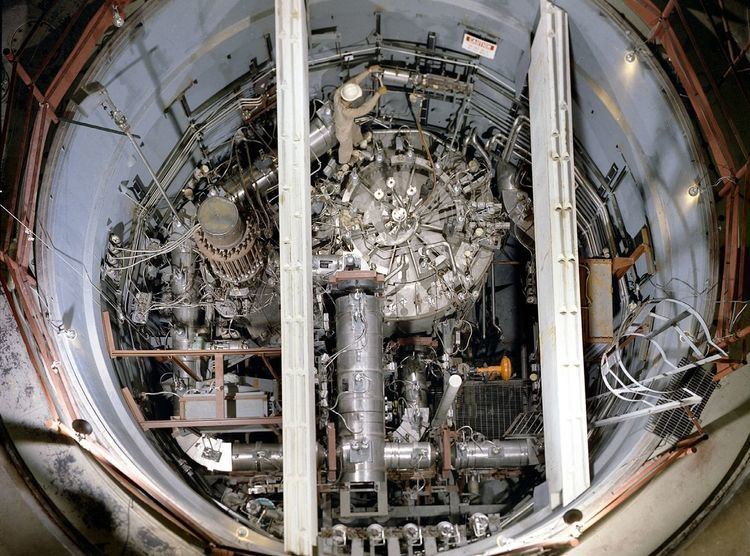 | ||
Uranium-233 is a fissile isotope of uranium that is bred from thorium-232 as part of the thorium fuel cycle. Uranium-233 was investigated for use in nuclear weapons and as a reactor fuel. It has been used successfully in experimental nuclear reactors and has been proposed for much wider use as a nuclear fuel. It has a half-life of 160,000 years.
Contents
- Fissile material
- Nuclear fuel
- Energy released
- Weapon material
- U 232 impurity
- Further information
- References
Uranium-233 is produced by the neutron irradiation of thorium-232. When thorium-232 absorbs a neutron, it becomes thorium-233, which has a half-life of only 22 minutes. Thorium-233 decays into protactinium-233 through beta decay. Protactinium-233 has a half-life of 27 days and beta decays into uranium-233; some proposed molten salt reactor designs attempt to physically isolate the protactinium from further neutron capture before beta decay can occur.
233U usually fissions on neutron absorption but sometimes retains the neutron, becoming uranium-234. The capture-to-fission ratio is smaller than the other two major fissile fuels uranium-235 and plutonium-239.
Fissile material
In 1946 the public first became informed of U-233 bred from thorium as "a third available source of nuclear energy and atom bombs" (in addition to U-235 and Pu-239), following a United Nations report and a speech by Glenn T. Seaborg.
The United States produced, over the course of the Cold War, approximately 2 metric tons of uranium-233, in varying levels of chemical and isotopic purity. These were produced at the Hanford Site and Savannah River Site in reactors that were designed for the production of plutonium-239. Historical production costs, estimated from the costs of plutonium production, were 2–4 million USD/kg. There are few reactors remaining in the world with significant capabilities to produce more uranium-233.
Nuclear fuel
Uranium-233 has been used as a fuel in several different reactor types, and is proposed as a fuel for several new designs (see Thorium fuel cycle), all of which breed it from thorium. Uranium-233 can be bred in either fast reactors or thermal reactors, unlike the uranium-238-based fuel cycles which require the superior neutron economy of a fast reactor in order to breed plutonium, that is, to produce more fissile material than is consumed.
The long-term strategy of the nuclear power program of India, which has substantial thorium reserves, is to move to a nuclear program breeding uranium-233 from thorium feedstock.
Energy released
The fission of one atom of U-233 generates 197.9 MeV = 3.171 × 10−11 J, i.e. 19.09 TJ/mol = 81.95 TJ/kg.
Weapon material
As a potential weapon material pure uranium-233 is more similar to plutonium-239 than uranium-235 in terms of source (bred vs natural), half-life and critical mass, though its critical mass is still about 50% larger than for plutonium-239. The main difference is the co-presence of uranium-232 which can make uranium-233 very dangerous to work on and quite easy to detect.
While it is thus possible to use uranium-233 as the fissile material of a nuclear weapon, speculation aside, there is scant publicly available information on this isotope actually having been weaponized:
The B Reactor and others at the Hanford Site optimized for the production of weapons-grade material have been used to manufacture U-233.
U-232 impurity
Production of 233U (through the irradiation of thorium-232) invariably produces small amounts of uranium-232 as an impurity, because of parasitic (n,2n) reactions on uranium-233 itself, or on protactinium-233, or on thorium-232:
232Th (n,γ) 233Th (β−) 233Pa (β−) 233U (n,2n) 232U232Th (n,γ) 233Th (β−) 233Pa (n,2n) 232Pa (β−) 232U232Th (n,2n) 231Th (β−) 231Pa (n,γ) 232Pa (β−) 232UAnother channel involves neutron capture reaction on small amounts of thorium-230, which is a tiny fraction of natural thorium present due to the decay of uranium-238:
230Th (n,γ) 231Th (β−) 231Pa (n,γ) 232Pa (β−) 232UThe decay chain of 232U quickly yields strong gamma radiation emitters:
232U (α, 68.9 years)228Th (α, 1.9 year)224Ra (α, 3.6 day, 0.24 MeV)220Rn (α, 55 s, 0.54 MeV)216Po (α, 0.15 s)212Pb (β−, 10.64 h)212Bi (α, 61 m, 0.78 MeV)208Tl (β−, 3 m, 2.6 MeV)208Pb (stable)This makes manual handling in a glove box with only light shielding (as commonly done with plutonium) too hazardous, (except possibly in a short period immediately following chemical separation of the uranium from its decay products) and instead requiring complex remote manipulation for fuel fabrication.
The hazards are significant even at 5 parts per million. Implosion nuclear weapons require U-232 levels below 50 ppm (above which the U-233 is considered "low grade"; cf. "Standard weapon grade plutonium requires a Pu-240 content of no more than 6.5%." which is 65000 ppm, and the analogous Pu-238 was produced in levels of 0.5% (5000 ppm) or less). Gun-type fission weapons additionally need low levels (1 ppm range) of light impurities, to keep the neutron generation low.
The Molten-Salt Reactor Experiment (MSRE) used U-233, bred in light water reactors such as Indian Point Energy Center, that was about 220 ppm U-232.
Further information
Thorium, from which U-233 is bred, is roughly three to four times more abundant in the earth's crust than uranium. The decay chain of 233U itself is in the neptunium series.
Uses for uranium-233 include the production of medical isotopes actinium-225 and bismuth-213, low-mass nuclear reactors for space travel applications, use as an isotopic tracer, nuclear weapons research, and reactor fuel research including the thorium fuel cycle.
The radioisotope bismuth-213 is a decay product of uranium-233; it has promise for the treatment of certain types of cancer, including acute myeloid leukemia and cancers of the pancreas, kidneys and other organs.
